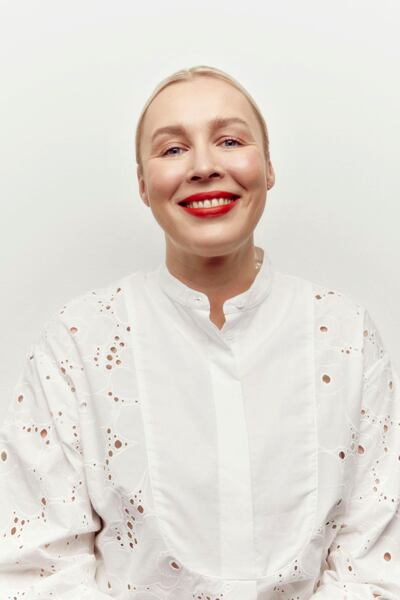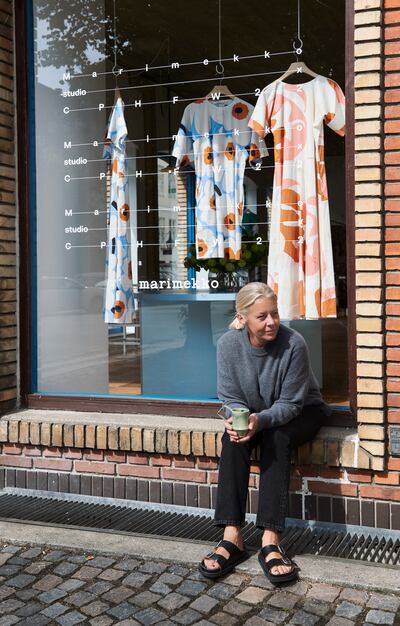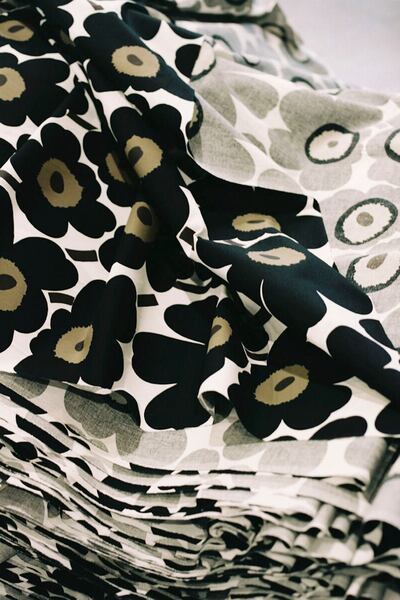
The Business of Fashion
Agenda-setting intelligence, analysis and advice for the global fashion community.

Agenda-setting intelligence, analysis and advice for the global fashion community.

The Finnish textile and lifestyle brand Marimekko was launched in 1951 by Armi Ratia and her husband Viljo with a radical premise for post-war Finland: bold prints and colours could be used to enrich the lives of the community and create joy in the everyday. Indeed, Armi Ratia believed that the Marimekko ethos could be universally applied to all creative mediums — it could have also been modern jazz or a flower shop, even building a printing facility large enough to construct Marimekko branded prefabricated homes, although an ambition that never came to fruition.
The textile company’s initial collection of refined yet humble dress silhouettes was designed to achieve two contrasting but complementary goals. First, to be practical enough to cater to the industriousness of its Finnish customers’ lives in the 50s, maintaining high enough quality that dresses could be passed down between generations. Second, to act as canvases on which artists could reflect the aesthetic awakening and newly emerging progressive societal movements of the 1950s through its now iconic prints.
With new designs created every year, the brand now has an archive of over 3,500 prints, which it is in the process of digitising and uploading to “Maripedia”, the Marimekko online print library. The company occasionally invites its community to vote on which archival print favourites should be reintroduced into its collections.
In 2021, the company’s net sales were €152 million and brand sales of the products worldwide amounted to €376 million. Globally, there are about 150 Marimekko stores, and its online store serves customers in 35 countries.
In order to scale the Marimekko business and continue to stimulate growth in international markets, Marimekko defined five strategic success factors it will focus on until 2027. These include: determined sustainability efforts, which it believes are tablestakes for long-term success; refining its creative vision to speak to a wider global audience; accelerating growth in Asia; developing end-to-end digitality and digital investments across channels; and critically maintaining its core cultural values.
Today, chief executive Tiina Alahuhta-Kasko and chief creative officer Rebekka Bay, although she prefers the title creative director, believe that in order to create a “flourishing future for a heritage brand, we need to go back to the roots of the DNA, understand them in-depth, and then have the courage to start boldly translating that into the future.”
As one of the ways to support this, the company founded Innovation Works, an in-house innovation hub charged with partnering with leading experts in material science, sustainable production, digital experiences and creativity, and a host of other future-facing capabilities that Marimekko believes will be relevant to the brand’s continuing metamorphosis to meet consumers where they are and serve them in a way that corresponds to their values.
As part of this optimisation for the future, Marimekko is more actively engaging with its role as a nordic and global opinion leader. At Helsinki’s annual Slush event, the world’s largest venture capital conference which attracts over 12,000 attendees and businesses like Google, Astra Zenixa, Shopify and Nokia, the brand hosted a panel discussion in partnership with BoF. Platforming renowned leaders from across the circular value chain, the panel represented Patagonia, Global Fashion Agenda, buzzy repair start-up Sojo, The Ellen MacArthur Foundation, Portugal’s respected Pedrosa factories, Swedish textile disruptor Renewcell, and Marimekko, to discuss how the industry can accelerate its circularity efforts before announcing the release of a pilot line of products partly using regenerated fibres from closed-loop production made in collaboration with Pedrosa’s manufacturing network.
Below, BoF meets chief executive Tiina Alahuhta-Kasko and chief creative officer Rebekka Bay to hear how the brand’s radically democratic values will continue to drive growth by creating joy.

How do the values of the Marimekko brand inform your strategy?
TA: We are a purpose-driven company. The way that our brand behaves, what we do, needs to be in line with our values. We have a democratic approach to design. We believe that good design is part of everyday life. Secondly, whatever the initiative is, we need to ensure that our core expertise combined with that of our partners creates real value for our end customer — and that joy needs to come through that.
The vision of our founder back in the 1950s was to make Marimekko a global phenomenon — people around the world share the same desire to find joy in the small and big things in everyday life. The mission of the brand has always been to empower people to be happy as they are, to bring joy to their everyday lives and challenge the conventional norms of the fashion industry with its proposition.
RB: I don’t think we are undergoing a significant cultural shift internally. This has been a continuing theme in the evolution of the brand. I think maybe the bigger shift is actually that we have gone back and asked ourselves if we launched today, how would we go about it? And that is exactly what we are doing. We are treating the brand as if we were launching today to reflect the shifts that were radical at the time when Marimekko was launched 70 years ago. It is more that we are starting to behave in accordance with our bold brand values again.
How have you navigated a challenging macroeconomic climate in recent years?
TA: Within the last 10-plus years, we started to take bigger steps into international markets. To capture the international growth opportunities, we identified a need to further sharpen and modernise our brand and collections, to strengthen our value proposition to customers around the world.
We need to go back to the roots of the DNA, understand them in-depth, and then have the courage to start boldly translating that into the future.
We realised that in order for us to create a flourishing future for our heritage brand, we need to go back to the roots of the DNA, understand them in-depth and then have the courage to start boldly translating that into the future. So that is a process that we started some years ago, with the collection modernisation, new segments, investments into digital, as well as increasing creativity in our physical retail experience.
Of course, the pandemic came. We managed it, luckily, very well. I think that our culture of internal entrepreneurship and agility paired with the growing interest in our brand supported us to mitigate those grey waters. Now, we are in an exciting phase in the sense that it is the moment when we are turning the page towards the future, to our next chapter.

You have created an innovation arm called Innovation Works to drive innovation via collaboration with partners. How big of a role will collaboration play in the future of the company as a result?
RB: We think of Innovation Works as a start-up within our organisation, because we need to behave and work on a different timeline from everyone else. What I love about start-ups is that you need to do everything. You sweep the floor, you think of big ideas, you pitch them yourself. You need to be able to do all of those things, which makes them agile. It makes them good at connecting across our organisation.
The brand was founded on artistic collaboration: you provide the art, our textiles provide the canvas. Today, we extend this to a new level of collaboration with our manufacturers, our suppliers, our material developers, digital creators, etc.
Ultimately, we identified that we need to innovate in technology, in materials and in business models to reach our long-term sustainability vision of our operations leaving no trace on the environment and overall to push the industry towards a more sustainable future. Those are now the three pillars of our innovation. In August this year, we also agreed on the ambition that we would become an opinion leader and explore what change we can make in this field by inspiring others. And, of course, by verbalising that ambition it started happening really fast. My reflection is: you need to identify your ambition because then you can move really fast towards it.
What operational evolution has that necessitated?
RB: We have previously worked in a traditional model where we design one season at a time and we bring it to market. Often, we work on four seasons at the same time. We realised that even though our intent was to bring real innovation and new materials to market or to help commercialise innovative materials, there was no way we could do that in that model. The model didn’t allow us to test, pilot or explore opportunities because it all needed to happen within the same timeline, which is why we saw the need to create Innovation Works.
I am quite comfortable with Marimekko extending to immaterial as well. We can create sensorial experiences, whether that is digital or in the physical world.
We needed to look at collaboration within our own organisation because we cannot have design in silo from production, or marketing, for example, creating and crafting messages in silo. We also need the teams to actually do the work in these functions, so we started to think much more about a task force, asking: “What does it take to actually create change?” And then we pulled individuals from different functions to collaborate and solve problems or projects, one project at a time.
You announced a new circular pilot in your manufacturing. How did that process come about?
RB: At this point, we sit at a pilot stage. What is amazing is that we have worked with Pedrosa and Rodriguez for many years — they are one of our biggest Jersey suppliers. At the same time, we were looking into future models. This is not just about replacing conventional materials — we literally need to come up with new production models — and Pedrosa were starting to collect waste of leftover material.
They had already started to collect our cut-off material and, early on in the process, they started to identify what the steps were that they needed to be circular. We could identify how to work with our own scrap or cut off waste, how to turn that into a proportion of new products. To ensure the quality and longevity of the pilot’s garments, a minimum of 20 percent of the material — depending on the product — will be regenerated cotton, and the rest will be virgin cotton. Of course, the intent is to continue to increase the share of recycled material.
TA: Through this pilot, we will be learning. It will allow us to explore ways to reduce the environmental impact of textile production. We will be able to have external experts produce a life cycle analysis of products using closed-loop fibres to support further development work.

Why is the metaverse important to a print and textiles brand?
TA: We are one of the first real lifestyle brands. Our founder used to say, when she founded the company, that Marimekko could have equally taken any other form of art. It could have even been a flower shop or modern jazz. Whatever we did, it needed to bring this joy and empowerment to people. Our unique identity revolving around the art of printmaking, which is world-renowned and recognisable, lends a lot of opportunities for exploring the different worlds where our brand values can come to life.
We need to be where our customers are. Our desire is to open up our design brand to speak to an even wider audience. We want to build our brand story together with our audience in a very inclusive manner. These sorts of explorations in new environments like the metaverse allow us to learn how to connect with the next generation, how to do storytelling, how to build the brand phenomenon in these new domains.
RB: 71 years ago, when Marimekko was founded, it was a radical business. I think back to this belief that Marimekko could be anything. So, of course our label can also be individual experiences. Our designs can also live outside of a physical product. I do have concerns about how we, in these new environments, protect the quality and integrity of our printmaking, which is as much about touch and tactility as the image. But I think we can protect the experience through the depth of our integrity in the experience. I am quite comfortable with Marimekko extending to immaterial as well. We can create sensorial experiences, whether that is digital or in the physical world, that are not all connected or related directly to physical products.
We firmly believe that the sustainability challenge cannot be solved from one aspect. We need to have multiple actions, explorations and innovations across the entire value chain.
The fact that we have a long history and heritage is a big asset for any brand. But the key question is how well we are able to build on that original treatise, but translate it in a way that resonates with the customers of tomorrow. Of course, the opportunities in today’s world with different areas of innovations allow us to build that brand phenomenon in a very optimistic, inclusive and democratic way.
How do you focus your efforts?
TA: We firmly believe that the sustainability challenge cannot be solved from one aspect. We need to have multiple actions, explorations and innovations across the entire value chain, and that is how we can build a more sustainable future for our industry. this is also key in building a flourishing future for our heritage brand. Our brand was founded on this idea of a creative community, as Rebekka said. This spirit of working together and enriching collaboration has always been ingrained in our culture.
It is this spirit of community and collaboration that we now strive to extend to a whole gamut of different partners in our value chain. This is quite unique in our industry to have an open approach to collaboration with partners. With this way of working, we want with our own little example to inspire the industry. We take the needed steps and investments to create a more sustainable future and do this together. We need each other.
This is a sponsored feature paid for by Marimekko as part of a BoF partnership.
Overconsumption and fast fashion have become easy targets for brands flexing their climate-friendly attributes. Consumers may agree with the message — but take issue with a self-righteous tone.
Traces of cotton from Xinjiang were found in nearly a fifth of samples from American and global retailers, highlighting the challenges of complying with a US law aimed at blocking imports that could be linked to forced labour in China.
The fashion industry continues to advance voluntary and unlikely solutions to its plastic problem. Only higher prices will flip the script, writes Kenneth P. Pucker.
The outerwear company is set to start selling wetsuits made in part by harvesting materials from old ones.